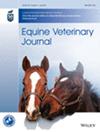Facial pressure beneath a cavesson noseband adjusted to different tightness levels during standing and chewing
Abstract
Background
Noseband adjustment should avoid discomfort and allow some jaw movement.
Objectives
To determine pressure beneath a cavesson noseband at five tightness levels during standing and chewing. It was hypothesised that increased noseband tightness is associated with increases in nasal and mandibular pressures while standing and chewing, accompanied by increases in eye temperature and blink rate.
Study design
Experimental.
Methods
Eight highly-trained dressage horses wore a snaffle bridle with their own bit. Pressure mats over the nasal bones and beneath the mandibular rami recorded sub-noseband pressures (50 Hz) for five tightness levels (2.0, 1.5, 1.0, 0.5, 0.0 finger-equivalents from loosest to tightest) measured using a taper gauge during quiet standing and chewing a treat. Eye temperature and blink rate were recorded synchronously. Data were analysed using Friedmans two-way ANOVA with Wilcoxon post hoc tests and Bonferroni adjustment for repeated measures. Significance level p ≤ 0.01.
Results
During standing, total force increased from (mean ± SD) 5.8 ± 4.4 N (nasal) and 12.3 ± 8.2 N (mandibular) at 2.0 finger-equivalents to 45.1 ± 24.9 N (nasal) and 70.7 ± 25.7 N (mandibular) at 0.0-finger-equivalents. Forces and pressures were higher on the mandibles than nasal bones although differences did not always reach statistical significance. Horses willingly ingested and chewed a treat at all noseband tightness levels generating forces ~100 N and pressure >40 kPa without increases in eye temperature or blink rate that would suggest discomfort. Post hoc tests indicated significantly higher pressure for 0.0 finger-equivalents than 2.0 finger-equivalents (p < 0.01).
Main limitations
Small sample size. Nosebands always tested from loosest to tightest.
Conclusions
Mandibular pressure exceeded nasal pressure and values at both sites increased with noseband tightness. Horses accepted high noseband pressures when chewing a treat with a cavesson adjusted from 0.0 to 2.0 finger-equivalents. Blink rate and eye temperature suggest horses were not distressed when chewing at 2.0 to 0.0 finger-equivalents tightness.

 求助内容:
求助内容: 应助结果提醒方式:
应助结果提醒方式:


